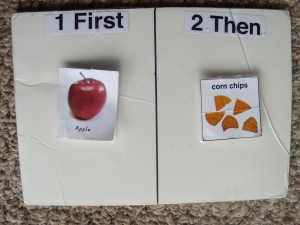Jackson stanchly refuses to ingest vegetables and anything green. The “Green Tree” incident (his sisters’ code name) will go down in history as perhaps our most dismal food failure: Trying to convince Jackson that we could outwit and outwait his opposition to broccoli.
You know those moments when you, the parent, make a brash statement like, “You will not eat anything else until you eat this.” We had commited ourselves to the battle. There was no backing down now. After almost two hours at the table and in time out, no supper, and the breakfast of champions (the dreaded “green trees”), he did finally choke down one tiny sprig. Yes, he actually did choke on it after holding it in his stationary mouth for I don’t know how long. But we, the exhausted parents, counted the accidentally ingested greenery as victory and finally gave in, feeding him some non-green food. Needless to say, that experiment did nothing to win him over or convince him to eat the color green (not even green m&ms). We decided that approach was not going to work with this little guy for the things he’s strongly averted to. We’ve since learned that children with autism can have pretty serious taste aversions that may actually register as a pain sensation or even a “that smells so bad, I am going to vomit” type reaction. Oral and olfactory (smelling) sensitivities can be so strong, that the children are completely overwhelmed and reject the food because of what it’s doing to them physically more than psychologically. I know, I know, the “Green Tree” incident will probably come up in a counseling session later in Jackson’s life. So, anyway, understanding this has helped, and Jackson’s teachers at school have introduced us to a much gentler, more gradual approach to overcoming taste aversions and helping Jackson tolerate a wider variety of foods.
Food Tolerance Expansion
So for the last several months at school, Jackson’s been warming up to turkey lunchmeat. With no preservatives or other yucky stuff, it’s a convenient protein, if he’ll eat it. Last week he progressed to licking the turkey (yes I said “licking”). This process of training a child to accept foods depends on the child and how strong their aversion to a particular food is, but can involve a series of steps to gradually and less traumatically introduce a new or previously unaccepted food: tolerating it in proximity to the plate, on the plate, touching it, “kissing” it (touching it to the lips), licking it, holding it in the mouth, chewing, and finally swallowing!
Using a visual “first/then” board with pictures depicting the expected behavior (licking the turkey) and the reward (eating a tortilla chip) has been crucial to this process. Jackson has submitted to eating chicken, sausage, even beans using this first/then board at home. I’ve even been able to fudge a couple of times when I didn’t have PEC’s for certain food: set the bowl on the first side, and the reward on the other. He understand what we expect, and it also eliminates reduces his frustration toward us. “The Board” is the boss and defines what will have to happen. He still has a choice, but it makes it much narrower and diminishes the potential for emotional distintigration (on our part or Jackson’s). I’m a big fan of this piece of foam with the line down the middle!
Do I still use hunger as a motivator? Oh yeah…I try to introduce new things when he’s at his hungriest and most willing. I usually keep a super healthy snack ready and waiting for him when he gets home from school and is ravenous. Knowing what he’ll tolerate helps, too. By gradually sneaking in healthy ingredients, I’m building up taste and smell tolerances that hopefully will turn into willing ingestion later. I’ve learned that things I think are bland by themselves (like cauliflower) take on an overbearing taste in certain dishes (cauliflower muffins: no good). And even a tiny bit of red pepper (it’s sweet, right?) is overwhelming in a frozen smoothie, but unnoticable in spaghetti sauce. He doesn’t seem to have any major oral sensitivies (taste, temperature, textures) other than avoiding soupy textures and green things.
My goal is to get as much good stuff in Jackson as possible and to make it as enjoyable for him as possible.
Snacks are definitely not fillers; they’re meals for him, so they’d better be good. There are some great tasting, convenient GFCF prepared foods out there, but I’ve found many of them are just carbs and organic sugar. In response, I’ve turned my kitchen into a lab, and my family are the guinea pigs for many covertly nutricious, veggie-filled, protein-packed GFCF recipies. Don’t worry, I don’t usually experiment on first-time guests…
Here’s our latest popular frozen treat:
Spinach/Fruit Smoothie Pops
3 cups blueberries
2 cups strawberries
1 peeled orange
2 peeled kiwi
1 TBS lemon juice
1 can pears or peaches, drained and rinsed
3-4 cups grape juice
3 cups spinach
a tsp of keifer water grains/probiotics
I use a vita mix and puree until smooth (no detectable green flecks), adjusting the amount of purple needed (grape juice as needed. We pour it in mugs to enjoy right away or into a tupperware popcicle maker for later. I’ve added airborn, and other supplements as needed, and down the hatch they go!
More GFCF recipies to come! For more general information about GFCF, see our Early Intervention site at AutismInterventions.org.

